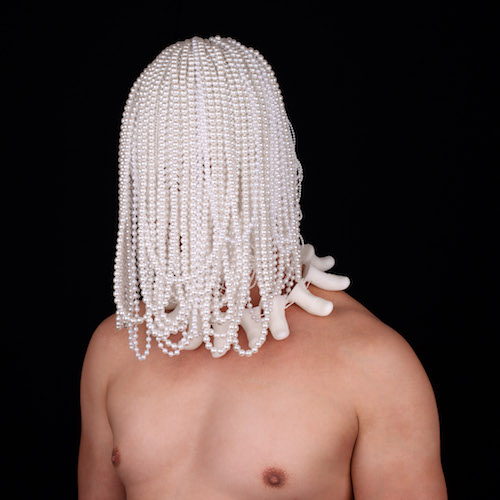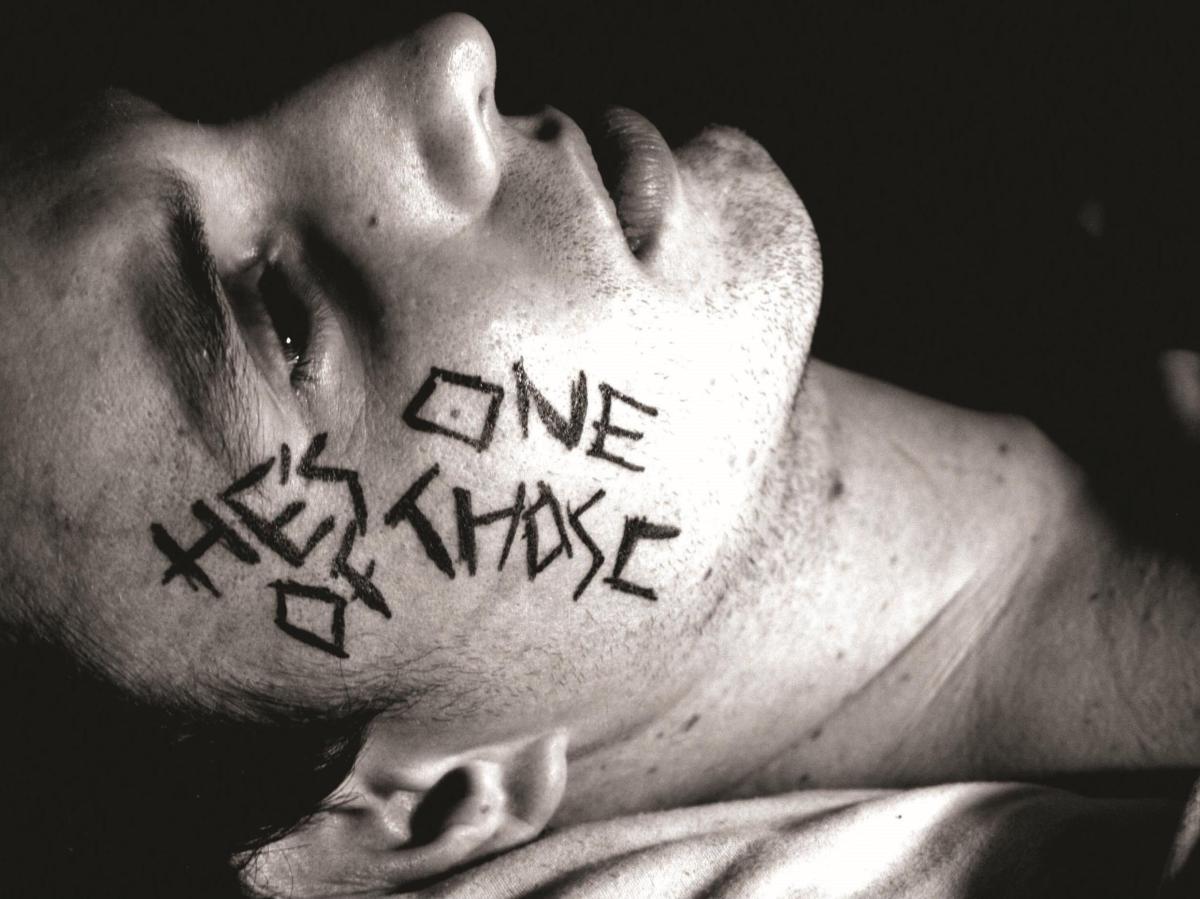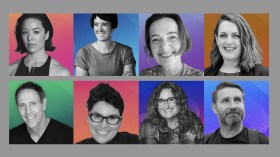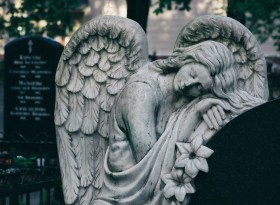Todd Fuller and Amy Hill, They’re Only Words, 2009 (detail) film, sound; Courtesy the artists and May Space, Sydney
Australia is in the midst of a national poll about one of the most pressing issues of our times – marriage equality. Accompanying the debate have been many images in the media (including stereotypes) of what it is to be a gay male.
Although the exhibition, The Unflinching Gaze has been more than two years in the planning, the timing of its opening this week has been serendipitous, given such concerns.
Director of Bathurst Regional Art Gallery (BRAG) and curator of the exhibition, Richard Perram OAM, told ArtsHub the exhibition’s primary focus was to look at how the gaze of another person – a gay male – can change how we perceive art.
‘The whole concept of what the male body looks like has changed, and continues to change. Through this exhibition, I was trying to say that your appreciation only becomes more interesting the more those other views are bought to the subject matter,’ he said.
Perram surveys how the male figure has been depicted in photography, film, fashion, pop video and homoerotic art – 140 years of images that explore how concepts of humanity and the male figure are intertwined and challenged.

While there have been queer exhibitions before this, Perram says BRAG’s exhibition is unique.
‘There has never been a show done like this in Australia. For most shows the curator is slightly anonymous, but I decided to make the curator central to the understanding of this exhibition. A lot of the exhibition is autobiographical, and it is an interest in things that affected me during my life: persecution as a gay person, the HIV/AIDS epidemic, censorship – topics I have worked with since the 1980s.’
This is Perram’s final exhibition with BRAG before retiring. He has been director of the regional gallery for 13 years.
It is the first major Australian photographic exhibition of the male gaze through LGBTI eyes, and consists of some 200-plus photographs and videos by artists such as the iconic Americans Robert Mapplethorpe and Andy Warhol; avant-garde theatre director Robert Wilson (a video portrait of Brad Pitt in his boxer shorts in the rain); European artists such as Eadweard Muybridge and Baron Wilhelm Von Gloeden, and photographs that document the impact of Nazi Germany and AIDS on gay men.
Among the Australians on show are Beaufoy Merlin and Charles Bayliss, Max Dupain, Deborah Kelly, William Yang, Gary Carsley, Owen Leong and Liam Benson.

Samuel J Hood, 9th Field Brigade 21/2/1948 Liverpool NSW photo negative copied from original nigrate photo 35mm; Collection State Library NSW
Understanding the male gaze
Perram told ArtsHub that his fascination in the male gaze started in 1965 when he bought a box of pin-up photos by UK artist David Bailey. ‘And there are four of those in the exhibition,’ he added excitedly. ‘I thought it was really important to take a group of Australian artists and place them in an international arena. These works just aren’t available in Australia.’
BRAG has borrowed 64 works from the Leslie-Lohman Museum of Gay and Lesbian Art in New York, as well as significant works from the National Gallery of Australia, the Art Gallery of NSW and other regional collections.
A work on that list – Bob Leet with Sheep, S.F. (1974) by Arthur Tress – nearly didn’t make it to Bathurst. It was contained by Australian Border Force as it was considered that it ‘may depict an act of bestiality’.
The photography of a naked man lying in bed with a sheep standing over him, was explained by the artist as containing no sexual content; in a statement Tress said it was just a toy purchased from FAO Schwarz.

Bob Leet with Sheep, S.F. (1974) by Arthur Tress; Leslie-Lohman Museum of Gay & Lesbian Art © Arthur Tress.
While BRAG delayed its shipment of artworks from the States until the situation had been cleared, ensuring no risk to the work, it got the green light from the Classification Board on 5 September. Nearly half the works in the exhibition have come from abroad.
Perram explained the importance of these international works, referring to a suite of six photographs by Dianora Niccolini obtained from a private collector in Tampa Florida. ‘This is first time her work has been seen outside of America, and the reason why she is so important is that she predates Mapplethorpe. She was the first person in America to exhibit the male nude photo in 1975. Mapplethorpe didn’t show until 1978,’ said Perram.
While most artists in the exhibition identify as LGBTI, also included is Max Dupain’s Sunbaker of 1937, and the work of Olive Cotton and Bill Henson. In a similar way, Perram turned to archival photographs of the 19th century to explore the idea of intimacy.
‘We have a series of photo from early 19th century America that show men obviously in relationships. While it is hard to know if there were gay or not, there’s a level of intimacy in those photographs that you don’t see today, which is interesting. It was a way of celebrating friendship,’ said Perram.
There are also studio portraits from the Bathurst Historical Society’s Gregory Collection that depict an innocent period of male friendship and the only known gay bushranger, Captain Moonlight.
Gregory Collection: Dan Cullen & Charles Gornall date unknown, digital copies from scanned negatives; Courtesy the Bathurst Historical Society
Completing the exhibition are images exploring the theme of transition and transgender – from images of Andy Warhol in drag to a suite of images taken in the 1960s in the resort Casa Susannah, a holiday resort in upstate New York where hetrosexual men paid $25 for a weekend to go and dress as women. These are borrowed from the Museum of Ontario.
They are displayed together with Mapplethorpe’s image of a gay porn star who is a body builder dressed in a bra and pants, alongside the publicity photographs of the same porn star – Roger Koch aka Frank Vickers. Perram explained: ‘Most people thing that a photograph tells the truth, but when you look at these two, which are both a construction, there is no truth.
‘We were trying to show a different way to look at art,’ he added.
Perran said the exhibition is meant to confuse you, to overwhelm you with the number of images.
‘It is all about the placement of the images. For example in a room we have just two images – Andy Warhol’s Blowjob (1964) and an early work by Australian artist Owen Leon where he poured honey over his face. They are two works separated by 40 years and they look at each other across the space.’
BRAG is working with local Bathurst LGBTI community groups to ensure that one of the most important outcomes of the exhibition will be to inform and educate the general Bathurst community and support and affirm the Bathurst LGBTI community.
The Unflinching Gaze: photo media and the male figure is showing at Bathurst Regional Art Gallery (BRAG) from Saturday 14 October until Sunday 3 December 2017.







